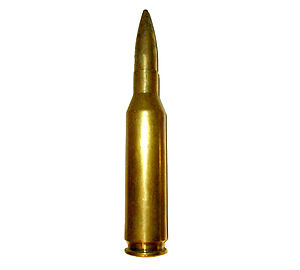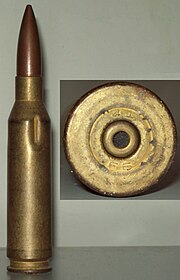| 14.5×114 mm | ||||||||||||||||||||||||
|---|---|---|---|---|---|---|---|---|---|---|---|---|---|---|---|---|---|---|---|---|---|---|---|---|
 14.5×114mm cartridge. | ||||||||||||||||||||||||
| Type | Anti-tank rifle, Heavy machine gun | |||||||||||||||||||||||
| Place of origin | Soviet Union | |||||||||||||||||||||||
| Service history | ||||||||||||||||||||||||
| In service | 1941 to present | |||||||||||||||||||||||
| Used by | Soviet Union and successor states | |||||||||||||||||||||||
| Wars | WWII, Soviet war in Afghanistan, War on Terror, 2011 Libyan civil war, and many other conflicts | |||||||||||||||||||||||
| Production history | ||||||||||||||||||||||||
| Designed | 1939 | |||||||||||||||||||||||
| Specifications | ||||||||||||||||||||||||
| Bullet diameter | 14.88 mm (0.586 in) | |||||||||||||||||||||||
| Neck diameter | 16.5 mm (0.65 in) | |||||||||||||||||||||||
| Shoulder diameter | 25.50 mm (1.004 in) | |||||||||||||||||||||||
| Base diameter | 26.95 mm (1.061 in) | |||||||||||||||||||||||
| Rim diameter | 26.95 mm (1.061 in) | |||||||||||||||||||||||
| Rim thickness | 2.5 mm (0.098 in) | |||||||||||||||||||||||
| Case length | 114 mm (4.5 in) | |||||||||||||||||||||||
| Overall length | 155.80 mm (6.134 in) | |||||||||||||||||||||||
| Case capacity | 42.53 cm3 (656.3 gr H2O) | |||||||||||||||||||||||
| Rifling twist | 455 mm (1 in 17.91 in) | |||||||||||||||||||||||
| Maximum pressure | 360 MPa (52,000 psi) | |||||||||||||||||||||||
Ballistic performance
| ||||||||||||||||||||||||
|
Test barrel length: 1350mm (53 inches) Source(s): Post WWII Ammunition Russian Ammunition Page | ||||||||||||||||||||||||
The 14.5×114 mm (.57 Cal) is a heavy machine gun and anti-materiel rifle cartridge used by the Soviet Union, the former Warsaw Pact, modern Russia, and other countries.
It was originally developed for the PTRS and PTRD anti-tank rifles, but was later used as the basis for the KPV heavy machine gun that formed the basis of the ZPU series anti-aircraft guns that is also the main armament of the BTR series of armoured personnel carriers from the BTR-60 to the BTR-80.
Cartridge dimensions[]
The 14.5×114 mm has 42.53 ml (655 grains H2O) cartridge case capacity. The exterior shape of the case was designed to promote reliable case feeding and extraction in bolt action rifles and machine guns alike, under extreme conditions.
14.5×114 mm maximum cartridge dimensions. All dimensions in millimeters (mm).
Americans would define the shoulder angle at alpha/2 ≈ 22.50 degrees. The common rifling twist rate for this cartridge is 455 mm (1 in 17.91 in), 8 grooves, Ø lands = 14.50 mm, Ø grooves = 14.95 mm.
According to the official guidelines the 14.5×114 case can handle up to 360 MPa (52213 psi) piezo pressure. In C.I.P. regulated countries every rifle cartridge combo has to be proofed at 125% of this maximum C.I.P. pressure to certify for sale to consumers.
Ammunition types[]
- BS: Armor-piercing incendiary original anti-tank round. The projectile weighs 64.4 grams and is 51 millimeters long with a 38.7 gram core of tungsten carbide with 1.8 grams of incendiary material in the tip. The overall round weighs approximately 200 grams and is 155 millimeters long. The projectile has a muzzle velocity of approximately 1,006 meters per second and can penetrate 40 millimeters of steel at an incidence of 60 degrees at a range of 100 meters, or 32 millimeters at a range of 500 meters.[1]
- B-32: Armor-piercing incendiary full metal jacket round with a hardened steel core. Projectile weight is 64 g and muzzle velocity is 1006 m/s. Armour penetration at 500 m is 32 mm of RHA at 90 degrees.
- BZT: Armor-piercing incendiary tracer full metal jacket round with a steel core. Projectile weight is 59.56 g and muzzle velocity is 1,006 m/s. Tracer burns to at least 2,000 m.
- MDZ: High-explosive incendiary bullet of instant action. Projectile weight is 59.68 g.
- ZP: Incendiary tracer round

Cartridges use lacquered steel cases and a percussion primer. Some countries also use brass cartridge cases. The propellant consists of 28.8 g smokeless powder with seven tubes, designated as 5/7NA powder. Two different versions of bullet series are known, the earlier had a conventional bullet jacket with boat-tail. These had a long engraving portion that caused considerable barrel wear. The newer bullet types have a smaller engraving portion with a rounder boat-tail and were used from about 1957 on.
14.5×114mm ammunition has been manufactured in Bulgaria, China, Egypt, Hungary, Iraq, North Korea, Poland, Romania, Russia, and the former Czechoslovakia. Of special note are the new Chinese armor-piercing types:[2]
- DGJ02: AP-T cartridge uses a 45 g tungsten penetrator, wrapped in a discarding sabot (similar to the US military SLAP cartridges) with dual colour tracer to aid ranging. The sabot splits and leaves the penetrator between 150 and 200 m from the muzzle. It has a muzzle velocity of 1,250 m/s and is quoted as being able to penetrate 20 mm of armour plate set at an angle of 50° at 800 m.
- DGE02: APHEI cartridge weighs between 175 and 188 g. At 800 m it is quoted as having a 90 percent chance of being able to penetrate 15 mm of armour plate set at 300. At 300 m after penetrating a 2 mm soft steel plate (representing an aircraft skin) it can further penetrate a 1.2 mm thick steel plate producing 20 fragments. Upon explosion between 75 and 95 incendiary pieces are formed which have an 80% chance of igniting aviation fuel.
Chambered weapons[]
Anti-materiel rifles
- Anzio rifle
- Denel NTW-20
- Gepard M-3
- Gepard M-6
- Istiglal IST-14.5
- Mambi-1 AMR
- PTRS-41 (anti-tank rifle)
- PTRD-41 (anti-tank rifle)
- Shaher[3]
- Truvelo 14.5×114mm
- Vidhwansak
Machine guns
- Slostin machine gun (heavy variant)
- KPV heavy machine gun
- Type 02/QJG-02 heavy machine gun[4]
- Chinese Type 56 & Type 58 heavy machine guns
Other
- ZPU anti-aircraft guns
- 2Kh35 Inserted unified self-loading gun[5]
See also[]
References[]
- ↑ "Russian Ammunition Page". http://www.russianammo.org/Russian_Ammunition_Page_145mm.html#4. Retrieved 7 December 2009.
- ↑ Andrew, Martin (March 2009 – April 2012). "PLA Mechanised Infantry Division Air Defence Systems". Air Power Australia. http://www.ausairpower.net/APA-PLA-Div-ADS.html#mozTocId278413. Retrieved 20-Nov-2012.
- ↑ "Iran unveils new tactical vehicle, sniper rifle". Tehran Times. http://tehrantimes.com/politics/101891-iran-unveils-new-tactical-vehicle-sniper-rifle. Retrieved 18 November 2012.
- ↑ QJG 02 Heavy Machine Gun
- ↑ 2Kh35 Inserted unified self-loading gun
Further reading[]
| Wikimedia Commons has media related to 14.5x114. |
- Koll, Christian (2009). Soviet Cannon - A Comprehensive Study of Soviet Arms and Ammunition in Calibres 12.7mm to 57mm. Austria: Koll. p. 91. ISBN 978-3-200-01445-9. Archived from the original on 19 October 2009. http://web.archive.org/web/20091019161335/http://www.russianammo.org/. Retrieved 21 November 2009.
| |||||||||||||||||||||||
| ||||||||
The original article can be found at 14.5×114mm and the edit history here.
